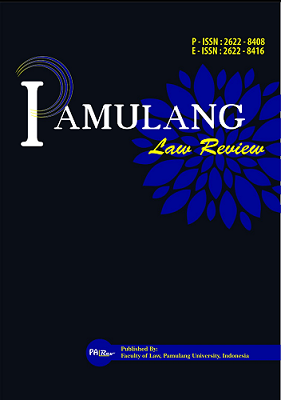Perlindungan Hukum Korban Begal Dalam Upaya Pembelaan Terpaksa Di Tinjau Berdasarkan Pasal 49 KUHP
DOI:
https://doi.org/10.32493/palrev.v7i1.43287Keywords:
Legal Protection, Victims of Robbery, Perforce ReviewedAbstract
Not everyone who becomes a victim Robbery is silent and resigned. There are also victims of robbery who make every effort to defend themselves, their property, their honor, and their lives. In an effort to protect himself, someone who fights back by attacking the perpetrator who tries to take his property is a form of defense from someone under compulsion or in the Criminal Code is known as Noodweer. This study uses a type of normative research. The data collection method used in this research is library research. The source of the data in this study is secondary data, namely data obtained indirectly from the source from literature studies that have a relationship with the research object taken in the protection of robbery victims in perforce reviewed. Noodweer is used as a justification, but not as a reason to justify an unlawful act, but rather someone who is forced to commit a crime is forgiven because there was a violation of the law that preceded the act. The causal relationship between attack and mental shock is perforce reviewed, and cannot eliminate the nature of breaking the law, but in conditions of mental shock, it can be a justifying reason or excuse that can abolish the punishment. Legislators must provide more detailed explanations of the articles so that they are more easily understood by the public, besides that it is hoped that there will be an update from the colonial Criminal Code into a new law. In addition, law enforcement officials must be able to pay more attention to the problem of victims with dual status so that legal protection for victims with dual status gets clarity about the rights they deserve.
References
Agung, A. A. G., Dewi, A. A. S. L., & Widyantara, I. M. M. (2021). Perlindungan Hukum Terhadap Pelaku Pembunuhan Begal Atas Dasar Pembelaan Terpaksa. Jurnal Interpretasi Hukum, 2(1), 1–7.
Andriani, A., & Aji, A. B. W. (2022). Pertanggungjawaban Pidana Bagi Korban Kejahatan Begal Yamg Melakukan Pembelaan Terpaksa. Ta’zir: Jurnal Hukum Pidana, 6(1), 1–13.
Bahasa, B. P. D. P. (2016). Kamus Besar Bahasa Indonesia.
Faizal, M. (2021). PERLINDUNGAN HUKUM BAGI PELAKU TINDAK PIDANA PEMBUNUHAN KARENA PEMBELAAN DARURAT YANG MELAMPAUI BATAS (NOODWEER EXCEES). Jurnal Dinamika, 27(1), 2937–2952.
Fajar, M., & Achmad, Y. (2017). Dualisme Penelitian Hukum : Normatif & Empiris. Pustaka Pelajar.
Kanter, E. ., & Sianturi, S. . (2002). Asas-Asas Hukum Pidana di Indonesia dan Penerapannya. Storia Grafika.
Marselino, R. (2020). Pembelaan Terpaksa yang Melampaui Batas (Noodweer Exces) Pada Pasal 49 Ayat (2). Jurist-Diction, 3(2), 633–647. https://doi.org/10.20473/jd.v3i2.18208
Muchsin. (2003). Perlindungan dan Kepastian Hukum Bagi Investor di Indonesia. Universitas Sebelas Maret.
Muhammad, A. (2014). Hukum Perdata Indonesia. Citra Aditya Sakti.
Saraswati, S. I., Warka, M., & Setyadji, S. (2022). Perlindungan Hukum Terhadap Korban Tindak Pidana Informasi Dan Transaksi Elektronik (ITE) Yang Melanggar Kesusilaan. Jurnal Inovasi Penelitian, 3(4), 5789–5798.
Soesilo. (1988). Kitab Undang-Undang Hukum Pidana (KUHP) Serta Komentar-Komentarnya Lengkap Pasal Demi Pasal,. Politeia.
Waluyo, B. (2011). Viktomologi Perlindungan Korban & Saksi. Sinar Grafika.
Widnyani, I. A. M., Dewi, A. A. S. L., & Karma, N. M. S. (2020). Tinjauan Yuridis terhadap Pembelaan Terpaksa (Noodweer) sebagai Alasan Penghapus Pidana. Jurnal Preferensi Hukum, 1(1), 195–200. https://doi.org/10.22225/jph.1.1.2007.195-200
Downloads
Published
How to Cite
Issue
Section
License

This work is licensed under a Creative Commons Attribution-ShareAlike 4.0 International License.
Penulis yang artikelnya diterbitkan pada Jurnal Pamulang Law Review ini menyetujui persyaratan berikut:
- Penulis memiliki hak cipta dan memberikan hak jurnal untuk publikasi pertama dengan karya yang secara simultan dilisensikan di bawah Creative Commons Attribution License yang memungkinkan orang lain untuk berbagi karya dengan pengakuan kepengarangan karya dan publikasi awal dalam jurnal ini.
- Penulis dapat mengadakan perjanjian kontrak tambahan yang terpisah untuk distribusi non-eksklusif versi jurnal yang diterbitkan dari karya tersebut (misalnya, mempostingnya ke repositori institusional atau menerbitkannya dalam sebuah buku), dengan pengakuan atas publikasi awalnya di jurnal ini.
- Penulis diizinkan dan didorong untuk memposting pekerjaan mereka secara online (mis., Dalam repositori institusional atau di situs web mereka) sebelum dan selama proses pengajuan, karena dapat menyebabkan pertukaran yang produktif, serta kutipan yang lebih awal dan lebih besar dari karya yang diterbitkan. Lihat (The Effect of Open Access).










